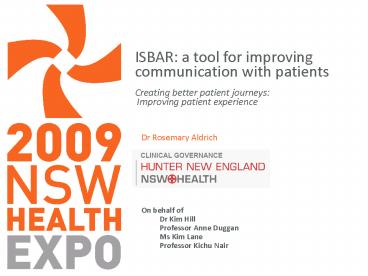ISBAR: a tool for improving communication with patients - PowerPoint PPT Presentation
1 / 17
Title:
ISBAR: a tool for improving communication with patients
Description:
ISBAR: a tool for improving communication with patients. Creating better ... to train HNE ... be learned in 15 minutes, even if delivered opportunistically ... – PowerPoint PPT presentation
Number of Views:3476
Avg rating:2.0/5.0
Title: ISBAR: a tool for improving communication with patients
1
ISBAR a tool for improving communication with
patients Creating better patient journeys
Improving patient experience
Dr Rosemary Aldrich
On behalf of Dr Kim Hill Professor Anne
Duggan Ms Kim Lane Professor Kichu Nair
2
IntroductionSituationBackgroundAssessmentR
ecommendation
1
3
Aim
- The ISBAR project aimed
- to develop and test a communication tool and
- ? to train HNE Health staff to use it
- ? to optimise clinical communication in
inter-hospital transfer - ? to effect improvements in the
experience of patients and carers
4
Nature and extent of the problem
- Director Clinical Governance established the HNE
Health Clinical Communication Steering Group in
2007 - Evaluation of incidents, complaints and
international literature showed that - poor communication was a common theme in
patient complaints, serious adverse events and
tragic experiences for patients, their carers and
health care workers, and yet - uptake of standardised communication systems
was difficult to achieve - ISBAR inter-hospital transfer project conceived
early 2008 (funded by Australian Commission on
Safety and Quality in Health Care) - Project team established early (through surveys,
focus groups and interviews) that many staff
lacked confidence in their ability and skill to
communicate effectively with patients, their
carers and other staff
5
Strategic importance
- The ISBAR project to improve communication in
inter-hospital transfer addressed a priority area
in patient care and safety - We demonstrated that the ISBAR approach to
communication improved the patient experience,
was rapidly learnt by health professionals,
improved the quality of clinical communication,
and holds great promise in reducing incidents in
which poor communication is a root cause
6
Planning implementing solutions
- Led by an Executive Team and guided by a Project
Steering Committee - Informed by input from patients, carers,
clinicians, managers and patient transport
officers we adapted the ISBAR communication tool
to improve clinical communication specifically
concerning handover in inter-hospital transfer of
patients and their care - Trained staff to use the ISBAR format and
recommended its use for communication with
patients, carers and other staff - Evaluated how staff training in ISBAR affected
the quality of the communication experienced
during 77 inter-hospital transfers by patients,
carers, clinicians and other staff
7
Outcomes evaluation
- More than 260 staff trained in ISBAR using a
15-minute training program - Achieved statistically significant improvements
in self-reported confidence and skill in
communicating effectively in clinical handover
8
Shift in staff confidence and skill in handover
(n262)
9
Outcomes evaluation
- More than 300 patients, carers and clinicians
were interviewed about the 50 inter-hospital
transfers which occurred after staff were trained
- Demonstrated improvements in patient and carer
perceptions of quality of communication across
seven elements, compared to baseline (before
staff were trained in ISBAR)
8
10
Patients perceptions of the quality of
communication with them before and after staff
were trained
11
Outcomes evaluation
- Improved quality of documentation which
accompanied the patient in key elements such as
having a nursing summary, including test reports
and documenting carers contact numbers for care - Doubled frequency of documenting that the patient
had been informed, although still much work to do
10
12
Audit of patient files documentation relating to
inter-hospital transfer
13
Lessons learned
- Patients, carers and staff know what they need to
improve their experience of communication in
health care ask them and involve them! - A sustainable, memorable and useable tool to
enhance communication can be learned in 15
minutes, even if delivered opportunistically - ISBAR serves all professional communication,
including communicating with patients and their
carers, escalating the deteriorating patient or
effecting clinical handover
14
Sustaining change
- Change became spontaneous and continues
- Tools made available, fielding constant requests
- ISBAR permeates all health communication in HNE
Health even Executive Briefs - A Communication Coalition is being established
as part of two-year project aiming to ensure all
staff are trained annually in and supported to
use ISBAR routinely - Making quality practice the usual practice is a
key strategy of Clinical Governance in action
15
14
16
Future scope
- Preliminary data suggest increased SAC 3 and 4
incident reporting at target hospital - Plan to evaluate incidents related to
communication to determine whether using ISBAR
across HNE Health leads to - reduction in number and average severity of
incidents - reduction in SAC 1 incidents in which
communication issues are nominated as a root
cause - Plan to evaluate confidence levels of staff in
clinical communication
17
Thank you
- Questions?
16































